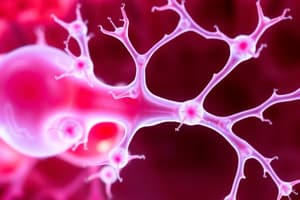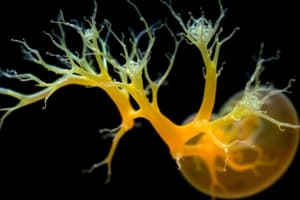Podcast
Questions and Answers
Unique to vertebrate embryos is a band of cells called the ______, which develops along the border where the neural tube pinches off from the ectoderm.
Unique to vertebrate embryos is a band of cells called the ______, which develops along the border where the neural tube pinches off from the ectoderm.
neural crest
Neural crest cells migrate throughout the embryo, forming peripheral nerves, parts of teeth, skull bones, and so many other different cell types that some developmental biologists have proposed considering the neural crest as a fourth ______.
Neural crest cells migrate throughout the embryo, forming peripheral nerves, parts of teeth, skull bones, and so many other different cell types that some developmental biologists have proposed considering the neural crest as a fourth ______.
germ layer
Somites form in strips of mesoderm lateral to the ______.
Somites form in strips of mesoderm lateral to the ______.
notochord
Parts of the notochord persist into adulthood as the inner portions of vertebral ______.
Parts of the notochord persist into adulthood as the inner portions of vertebral ______.
Embryonic development leads to an aquatic, herbivorous tadpole larva, which later metamorphoses into a terrestrial, carnivorous adult ______.
Embryonic development leads to an aquatic, herbivorous tadpole larva, which later metamorphoses into a terrestrial, carnivorous adult ______.
Organogenesis in the chick is similar to the process in the ______.
Organogenesis in the chick is similar to the process in the ______.
A high concentration of a growth factor called bone morphogenetic protein 4 (BMP-4) is present on the ______ side of the gastrula.
A high concentration of a growth factor called bone morphogenetic protein 4 (BMP-4) is present on the ______ side of the gastrula.
Organizer cells inactivate BMP-4 on the ______ side of the embryo.
Organizer cells inactivate BMP-4 on the ______ side of the embryo.
The inactivation of BMP-4 promotes the formation of ______ structures such as the notochord and neural tube.
The inactivation of BMP-4 promotes the formation of ______ structures such as the notochord and neural tube.
In tissues between the dorsal and ventral sides, a lower concentration of BMP-4 results in ______ structures appropriate for the specific location along the dorsal-ventral axis.
In tissues between the dorsal and ventral sides, a lower concentration of BMP-4 results in ______ structures appropriate for the specific location along the dorsal-ventral axis.
The varying concentration of BMP-4 along the dorsal-ventral axis is an example of a ______ gradient.
The varying concentration of BMP-4 along the dorsal-ventral axis is an example of a ______ gradient.
In late gastrula of the frog, ectoderm cells destined to form the lenses of the eyes receive precisely timed inductive signals from ectodermal, mesodermal, and endodermal cells, showcasing the role of inductive signals in ______ formation.
In late gastrula of the frog, ectoderm cells destined to form the lenses of the eyes receive precisely timed inductive signals from ectodermal, mesodermal, and endodermal cells, showcasing the role of inductive signals in ______ formation.
In some species, the cells of the early gastrula retain the capacity to give rise to more than one kind of cell, although they are no longer ________.
In some species, the cells of the early gastrula retain the capacity to give rise to more than one kind of cell, although they are no longer ________.
If transplanted, the cells respond to their new location and develop appropriately, showcasing the role of ________ signals in cell fate determination.
If transplanted, the cells respond to their new location and develop appropriately, showcasing the role of ________ signals in cell fate determination.
Late gastrula cells give rise to the same type of cells they would have become in their original position due to the fixed tissue-specific ________.
Late gastrula cells give rise to the same type of cells they would have become in their original position due to the fixed tissue-specific ________.
Hans Spemann and Hilde Mangold's transplantation experiments showed that the dorsal lip of the blastopore in an early gastrula serves as an 'organizer' initiating a chain of inductions for the formation of the notochord, neural tube, and other organs in ________.
Hans Spemann and Hilde Mangold's transplantation experiments showed that the dorsal lip of the blastopore in an early gastrula serves as an 'organizer' initiating a chain of inductions for the formation of the notochord, neural tube, and other organs in ________.
The effect of induction is usually the switching on of a set of genes that make the receiving cells differentiate into a specific tissue, such as the ________.
The effect of induction is usually the switching on of a set of genes that make the receiving cells differentiate into a specific tissue, such as the ________.
Developmental biologists are working to identify the molecular basis of induction by Spemann’s organizer, also known as the gastrula organizer or simply the ________.
Developmental biologists are working to identify the molecular basis of induction by Spemann’s organizer, also known as the gastrula organizer or simply the ________.
Flashcards are hidden until you start studying




